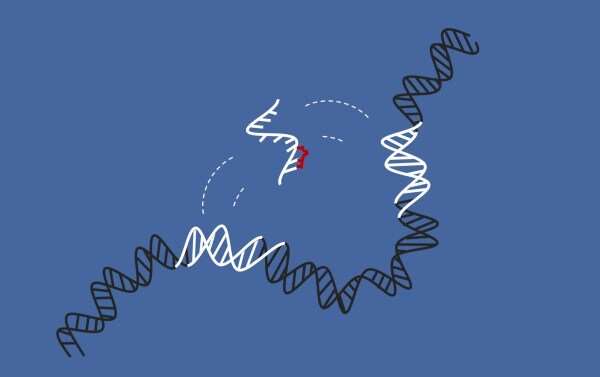New data on 'jumping genes' linked to cancer

Scientists from the University of Granada and GENYO have discovered a mechanism via which our cells protect themselves against these transposable or mobile genetic elements, known as "LINE-1," which are involved in the development and progression of many types of cancer
The results of this research have recently been published in Nature Communications
Scientists from the Department of Biochemistry and Molecular Biology II of the University of Granada (UGR) and the Pfizer-University of Granada-Andalusian Government Centre for Genomics and Oncological Research (GENYO) have discovered a mechanism via which our cells protect themselves against 'jumping genes' or transposable (mobile) genetic elements known as LINE-1 or L1.
These are DNA sequences that have the ability to 'jump' from one site to another within our genome. By inserting themselves randomly anywhere in the genome, the 'jumps' can cause diseases ranging from hemophilia to muscular dystrophy or cancer. In fact, L1s are known to be mobilized during the development of various types of cancer and may even cause it.
Although this study stems from basic research—research that produces knowledge that provides a better understanding of the biology and genetics of cancer—it could pave the way to an improvement in cancer treatments or to the design of new diagnostic or therapeutic strategies.
MicroRNAs (miRNAs) are small ribonucleic acid (RNA) molecules that regulate gene expression and play an important role in the control of cell proliferation (and therefore in preventing the onset of tumors). In this study, which has recently been published in the prestigious Nature Communications, the scientists discovered a previously-unknown role of 'let-7' (one of the most important microRNAs in the animal kingdom): maintaining genome integrity by restricting the 'jumps' or retrotranspositions made by L1.
DNA: An instruction book
Pablo Tristán, a researcher at GENYO and lead author of this work, explains that "our genome, our DNA, is the instruction book for our body. Within this book, the instructions for making proteins (the molecules that perform most of the functions of cells) are the genes. Yet, despite their importance, genes only occupy 2% of our genome, while half of the remaining 98% is made up of mobile genetic elements—DNA sequences that have the ability to 'jump' from one site to another within our genome. Fortunately for us, almost all of them have acquired mutations that prevent them from moving, and there is only one family left capable of making the proteins it needs to jump: the L1 elements."
The possible role of miRNAs as regulators of the mobile elements, and whether this regulation is important in the development of cancer, are under-studied topics. "We aimed to study whether any of these microRNAs could control L1 retrotranspositions and, therefore, if alterations in microRNA levels (a common feature in cancer) could contribute to the increase in L1 retrotranspositions observed in tumors," explains Sara Rodríguez Heras, Ramón y Cajal Research Fellow at the UGR's Department of Biochemistry and Molecular Biology II, who led the research project from GENYO.
In this study, the researchers demonstrated that lung cancer samples containing new L1 copies, distributed randomly throughout the genome, contain very low levels of the let-7 miRNA, which is known for its role as a tumor suppressor.
More L1 'jumps'
Tristán continues: "Next, we used various molecular and cellular biology techniques to demonstrate that, indeed, a reduction in the levels of this microRNA leads to an increase in L1 retrotransposition in cultured cells." In turn, if the levels of let-7 are increased, the number of copies of L1 that accumulate is reduced.
"Furthermore, using biochemical techniques, we discovered the molecular mechanism by which this occurs, which is basically that let-7 specifically recognizes this mobile genetic element and reduces the production of one of the proteins made by L1 that is essential for generating the new insertion," explains Rodríguez Heras.
In short, the researchers discovered the previously-unknown role of the tumor-suppressing miRNA let-7 family, to maintain the integrity of the genome and protect it from the mutagenic activity of mobile genetic elements.
More information: Pablo Tristán-Ramos et al. The tumor suppressor microRNA let-7 inhibits human LINE-1 retrotransposition, Nature Communications (2020). DOI: 10.1038/s41467-020-19430-4
Journal information: Nature Communications
Provided by University of Granada





















